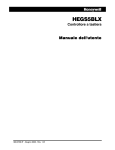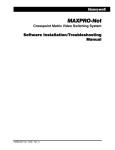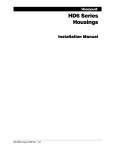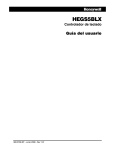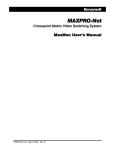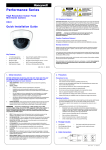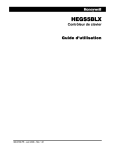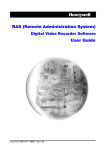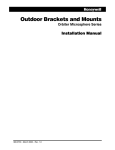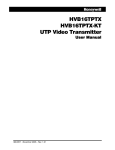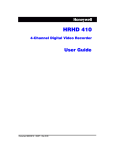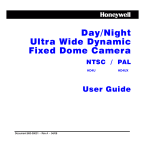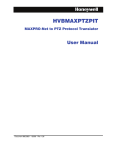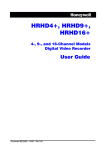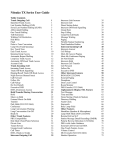Download HEGS5BLX User Guide - Honeywell Video Systems
Transcript
HEGS5BLX Keyboard Controller User Guide 900.0799 – June 2006 - Rev 1.01 ISSUE DATE REVISIONS 900.0723 1.0 May 2006 Initial Release 900.0799 1.0 June 2006 Correct controller power supply part #/add power supply part # to converter; correct RS232 RX/TX terminals on terminal block 1.01 June 2006 Revise connections to power connector Rev. 1.01 ii 900.0799 20-Jun-06 FCC COMPLIANCE STATEMENT INFORMATION TO THE USER: This equipment has been tested and found to comply with the limits for a Class A digital device, pursuant to part 15 of the FCC rules. These limits are designed to provide reasonable protection against harmful interference when the equipment is operated in a commercial environment. This equipment generates, uses, and can radiate radio frequency energy and, if not installed and used in accordance with the instruction manual, may cause harmful interference to radio communications. Operation of this equipment in a residential area is likely to cause harmful interference in which case the user will be required to correct the interference at his own expense. CAUTION: Changes or modifications not expressly approved by the party responsible for compliance could void the user’s authority to operate the equipment. This Class A digital apparatus complies with Canadian ICES-003. Cet appareil numérique de la Classe A est conforme à la norme NMB-003 du Canada. USERS OF THE PRODUCT ARE RESPONSIBLE FOR CHECKING AND COMPLYING WITH ALL FEDERAL, STATE, AND LOCAL LAWS AND STATUTES CONCERNING THE MONITORING AND RECORDING OF VIDEO AND AUDIO SIGNALS. HONEYWELL VIDEO SYSTEMS SHALL NOT BE HELD RESPONSIBLE FOR THE USE OF THIS PRODUCT IN VIOLATION OF CURRENT LAWS AND STATUTES. Rev. 1.01 iii 900.0799 20-Jun-06 Rev. 1.01 iv 900.0799 20-Jun-06 IMPORTANT SAFEGUARDS 1. READ INSTRUCTIONS – All safety and operating instructions should be read before the unit is operated. 2. RETAIN INSTRUCTIONS – The safety and operating instructions should be retained for future reference. 3. HEED WARNINGS – All warnings on the unit and in the operating instructions should be adhered to. 4. FOLLOW INSTRUCTIONS – All operating and use instructions should be followed. 5. CLEANING – Unplug the unit from the outlet before cleaning. Do not use liquid cleaners or aerosol cleaners. Use a damp cloth for cleaning. 6. ATTACHMENTS – Do not use attachments not recommended by the product manufacturer as they may result in the risk of fire, electric shock, or injury to persons. 7. WATER AND MOISTURE – Do not use this unit near water or in an unprotected outdoor installation, or any area which is classified as a wet location. 8. ACCESSORIES - Do not place this product on an unstable cart, stand, tripod, bracket, or table. The product may fall, causing serious injury to a child or adult and serious damage to the equipment. Use only with a cart, stand, tripod, bracket, or table recommended by the manufacturer, or sold with the product. Any mounting of the product should follow the manufacturer’s instructions and should use a mounting accessory recommended by the manufacturer. Wall or shelf mounting should follow the manufacturer’s instructions and should use a mounting kit approved by the manufacturer. 9. A product and cart combination should be moved with care. Quick stops, excessive force, and uneven surfaces may cause the product and cart combination to overturn. 10. VENTILATION - Slots and openings in the cabinet and the back or bottom are provided for ventilation and to ensure reliable operation of the equipment and to protect it from overheating. These openings must not be blocked or covered. The openings should never be blocked by placing the product on a bed, sofa, rug, or other similar surface. Equipment should never be placed near or over a radiator or heat register. This product should not be placed in a built-in installation, such as a bookcase or rack unless proper ventilation is provided or the manufacturer’s instructions have been adhered to. 11. POWER SOURCES – This product should be operated only from the type of power source indicated on the marking label. If you are not sure of the type of power supplied to your home, consult your product dealer or local power company. For products designed to operate from battery power or other sources, refer to the operating instructions. 12. GROUNDING OR POLARIZATION – The power supply supplied with this unit may be equipped with a polarized alternating-current line plug (a plug having one blade wider than the other). This plug will fit into the power outlet only one way. This is a safety feature. If you are unable to insert the plug fully into the outlet, try reversing the plug. If the plug should still fail to fit, contact your electrician to replace your obsolete outlet. Do not defeat the safety purpose of the polarized plug. 13. OVERLOADING – Do not overload outlets and extension cords as this can result in a risk of fire or electric shock. Rev. 1.01 v 900.0799 20-Jun-06 IMPORTANT SAFEGUARDS 14. POWER-CORD PROTECTION – Power supply cords should be routed so that they are not likely to be walked on or pinched by items placed upon or against them, paying particular attention to cords and plugs, convenience receptacles, and the point where they exit from the monitor. 15. OBJECT AND LIQUID ENTRY – Never push objects of any kind into this unit through openings as they may touch dangerous voltage points or short-out parts that could result in a fire or electric shock. Never spill liquid of any kind on the unit. 16. SERVICING – Do not attempt to service this unit yourself as opening or removing covers may expose you to dangerous voltage or other hazards. Refer all servicing to qualified service personnel. 17. DAMAGE REQUIRING SERVICE – Unplug the unit from the outlet and refer servicing to qualified service personnel under the following conditions: a. When the power-supply cord or plug is damaged. b. If liquid has been spilled, or objects have fallen into the unit. c. If the unit has been exposed to rain or water. d. If the unit does not operate normally by following the operating instructions. Adjust only those controls that are covered by the operating instructions as an improper adjustment of other controls may result in damage and will often require extensive work by a qualified technician to restore the unit to its normal operation. e. If the unit has been dropped or the enclosure has been damaged. f. When the unit exhibits a distinct change in performance - this indicates a need for service. 18. REPLACEMENT PARTS – When replacement parts are required, be sure the service technician has used replacement parts specified by the manufacturer or have the same characteristics as the original part. Unauthorized substitutions may result in fire, electric shock or other hazards. 19. SAFETY CHECK – Upon completion of any service or repairs to this unit, ask the service technician to perform safety checks to determine that the unit is in proper operating condition. 20. LIGHTNING AND POWER LINE SURGES – For added protection of this unit during a lightning storm, or when it is left unattended and unused for long periods of time, unplug it from the wall outlet and disconnect the cable system. This will prevent damage to the unit due to lightning and power-line surges. 21. HEAT – The product should be situated away from heat sources such as radiators, heat registers, stoves, or other products (including amplifiers) that produce heat. 22. INSTALLATION – Do not install the unit in an extremely hot or humid location, or in a place subject to dust or mechanical vibration. The unit is not designed to be waterproof. Exposure to rain or water may damage the unit. 23. WALL OR CEILING MOUNTING – The product should be mounted to a wall or ceiling only as recommended by the manufacturer Rev. 1.01 vi 900.0799 20-Jun-06 EXPLANATION OF GRAPHICAL SYMBOLS The lightning flash with arrowhead symbol within an equilateral triangle is intended to alert the user to the presence of uninsulated "dangerous voltage" within the product's enclosure that may be of sufficient magnitude to constitute a risk of electric shock to persons. The exclamation point within an equilateral triangle is intended to alert the user to the presence of important operating and maintenance (servicing) instruction in the literature accompanying the product. CAUTION CAUTION RISK OF ELECTRIC SHOCK DO NOT OPEN CAUTION: TO REDUCE THE RISK OF ELECTRIC SHOCK, DO NOT REMOVE COVER (OR BACK). NO USER-SERVICEABLE PARTS INSIDE. REFER SERVICING TO QUALIFIED SERVICE PERSONNEL. WARNING WARNING: TO REDUCE THE RISK OF FIRE OR ELECTRIC SHOCK, DO NOT EXPOSE THIS PRODUCT TO RAIN OR MOISTURE. WARNING: DO NOT INSERT ANY METALLIC OBJECT THROUGH VENTILATION GRILLS THIS PRODUCT TO RAIN OR MOISTURE. WARNING: THIS UNIT MUST BE OPERATED WITH A PROPERLY GROUNDED 3-PIN CONNECTION. NON-OBSERVANCE OF THIS STANDARD PRACTICE MAY RESULT IN A STATIC ELECTRICITY BUILD-UP THAT MAY RESULT IN AN ELECTRIC SHOCK WHEN EXTERNAL CONNECTIONS ARE TOUCHED. Rev. 1.01 vii 900.0799 20-Jun-06 Notes: Rev. 1.01 viii 900.0799 20-Jun-06 TABLE OF CONTENTS SECTION 1: INTRODUCTON ................................................................................................................... 1 1.1 PRODUCT DESCRIPTION ............................................................................................................ 1 1.2 ADDITIONAL INFORMATION........................................................................................................ 1 SECTION 2: INSTALLATION AND EQUIPMENT SETUP......................................................................... 2 2.1 CONNECTIONS............................................................................................................................ 2 2.2 INSTALLATION DIAGRAM ............................................................................................................ 3 SECTION 3: OPERATION......................................................................................................................... 4 3.1 CONTROLS AND LCD DISPLAY .................................................................................................. 4 3.2 POWER UP ................................................................................................................................... 9 3.3 LOGIN/LOGOUT ........................................................................................................................... 9 3.4 MODES OF OPERATION............................................................................................................ 10 3.4.1 Camera Operation Mode ............................................................................................... 10 3.4.2 Monitor Operation Mode ............................................................................................... 11 3.4.3 DVR Operation Mode..................................................................................................... 11 3.4.4 Sequence Operation Mode ........................................................................................... 12 3.4.5 Alarm Acceptance.......................................................................................................... 12 3.4.6 LCD Function Keys F1-F10............................................................................................ 12 SECTION 4. HEGS5BLX CONFIGURATION ......................................................................................... 13 4.1 SYSTEM PARAMETERS ............................................................................................................. 13 SECTION 5: DOWNLOADING NEW FIRMWARE TO THE HEGS5BLX................................................. 14 5.1 INTRODUCTION ......................................................................................................................... 14 5.2 CONNECTING THE HEGS5BLX TO YOUR PC .......................................................................... 14 SECTION 6: TROUBLESHOOTING AND MAINTENANCE .................................................................... 19 6.1 TROUBLESHOOTING................................................................................................................. 19 6.2 DIAGNOSTICS............................................................................................................................ 19 6.2.1 Joystick Test Modes ...................................................................................................... 19 6.3 SERVICING THE CONTROLLER ................................................................................................ 20 6.4 PREVENTIVE MAINTENANCE.................................................................................................... 20 SECTION 7: SPECIFICATIONS .............................................................................................................. 21 Rev. 1.01 ix 900.0799 20-Jun-06 LIST OF FIGURES Figure 1: Connecting to the VideoBloX CPU Module.................................................................................... 3 Figure 2. Controls and LCD Display .............................................................................................................. 4 Figure 3. LCD Display and Soft Keys............................................................................................................. 8 Figure 4: Ultrak Code Server Window ........................................................................................................... 15 Figure 5: CommPort Properties Window ....................................................................................................... 15 Figure 6: Enabling the CommPort ................................................................................................................. 16 Figure 7: Invalid Port Error ............................................................................................................................. 16 Figure 8. Transmit Hex File ............................................................................................................................ 16 Figure 9: Send Hex File Window ................................................................................................................... 17 Figure 10: Selecting the Hex File to Send ..................................................................................................... 17 Figure 11: Sending Hex File Status Window ................................................................................................. 18 Figure 12. Transfer Complete ........................................................................................................................ 18 Rev. 1.01 x 900.0799 20-Jun-06 SECTION 1: INTRODUCTON 1.1 PRODUCT DESCRIPTION The HEGS5BLX is a remote keyboard controller for Honeywell Video's VideoBloX range of video matrix switching and control equipment. Many common functions required in controlling a medium to large sized CCTV installation may be readily carried out from a single compact keyboard. The major functions, which have been integrated into the unit, are the control of the video matrix switching equipment, pan tilt zoom units (PTZs), video cassette recorders (VCRs), Digital Video Recorders (DVRs), controlling the operation of sequences and the monitoring of alarms. Refer to the associated CPU and Protocol Interface Translator (PIT) manuals for specific operation of peripheral devices. The HEGS5BLX only works in slave mode and cannot be used to control telemetry equipment in stand alone mode. 1.2 ADDITIONAL INFORMATION CAUTION: Users of this product are responsible for checking and complying with all federal, state, and local laws and statutes concerning the monitoring and recording of video and audio signals. Honeywell shall not be held responsible for the use of this product in violation of current laws and statutes. Rev. 1.01 1 900.0799 20-Jun-06 SECTION 2: INSTALLATION AND EQUIPMENT SETUP 2.1 CONNECTIONS A terminal block is provided for connection between the HEGS5BLX keyboard controller and peripheral equipment. A 6-conductor crossover cable is provided for connection between the HEGS5BLX and the terminal block. Plug one end of the crossover cable into the connector on the back of the HEGS5BLX and the other end into the jack on the terminal block. Power Supply COM1 (RS485 output port) COM2 (RS232 serial port) Description Connect to power supply, part number 849193-0089, provided with the keyboard. RS485 D+and D- (Not Used) RS232 RX and TX GND +12VDC RS-232 (TX) - COM2 RS-485 (D-) - COM1 RS-232 (RX) - COM2 RS-485 (D+) - COM1 Rev. 1.01 2 900.0799 20-Jun-06 2.2 INSTALLATION DIAGRAM HVB232422 RS-485 (D-) RS-485 (D+) RS-232 (RX) Part #140.0101 RS232 to RS422 Converter +12VDC GND RS-232 (TX) Honeywell Part# 849193-0089 4-Wire RS422 w/Terminator 4-Wire RS422 ON PSU 12 VDC 2A ON RS422 WITH TERMINATOR SW1 SW2 SW3 ON ON ON 1 2 3 1 2 3 Note: White Space Shows Switch Position Female DB9 RS232 Pin 5, GND Pin 3, RXD Pin 2, TXD RS422 SW1 SW2 SW3 ON ON OFF `` Female DB9 5 9 4 3 8 2 7 1 6 VideoBloX CPU Module RS422 Master DB9 RS-232 (TX) GND +12VDC V+ VGND RS-232 (RX) RS-485 (D+) RS-485 (D-) Part #849518-0419 6x6 Crossover Cable TX+ (B) TX- (A) RX+ (B) Data + RX- (A) Data RTS+ (B) RTS- (A) CTS+ (B) CTS- (A) SGND Pin 3, RX+ Pin 4, RXPin 2, TX+ Pin 1, TXPin 5, GND + 12-30 VDC Power Supply Part #849193-0089 Multiplexer DVR HEGS5BLX VideoBloX Controller Figure 1: Connecting to the VideoBloX CPU Module Rev. 1.01 3 900.0799 20-Jun-06 SECTION 3: OPERATION 3.1 CONTROLS AND LCD DISPLAY The functionality and operation of the HEGS5BLX is dependent on the installation and configuration of the VideoBloX switching system. The functionality of the DVR (device) key and DVR AUX key is dependent on the device (multiplexer, DVR, VCR, etc.) database defined and selected in the VideoBloX configuration software. Refer to the VideoBloX Matrix Configuration Manual for details on configuring the software. The camera key and camera AUX key functionality is dependent on the PTZ protocol settings in the HVBPIT44 Protocol Translator. Refer to the HVBPIT44 User Manual for protocol settings and auxiliary functions. 2 4 5 21 22 23 HEGS5BLX System Controller 3 1 1 2 3 4 5 6 7 8 9 + 0 AUX1 AUX 2 AUX 3 AUX 4 AUX 5 AUX 6 AUX 7 AUX 8 / 6 SEQ 7 8 9 10 11 12 13 ALM ACK 14 User 1 / 2 Preset/Save User 3 / 4 ALT AUX 15 16 17 18 19 20 Figure 2. Controls and LCD Display ID Icon 1 2 Rev. 1.01 + Usage Description Numeric Keypad Used to enter numbers in programming screens and entering passwords, camera numbers, monitor numbers, and other device numbers. Plus Key Used to select the next device depending on the operation mode (camera, monitor, sequence, DVR.) 4 900.0799 20-Jun-06 ID Icon Usage Description 3 Minus Key Used to select the previous device depending on the operation mode (camera, monitor, sequence, DVR.) 4 Camera Key Camera Mode 5 Monitor Key Monitor Mode 6 Enter Key Used to confirm a selection The operation of Keys 7 to 14 is dependent on the controller mode of operation and on the system configuration defined in the VideoBloX CPU module. • 7-14 7 8 9 10 11 Rev. 1.01 To lock the controller in DVR mode, press the DVR key. To lock the controller in PTZ Auxiliary or DVR Auxiliary mode, press the AUX key twice. The function of the auxiliary key is determined by the system mode of the controller (Camera mode or DVR mode) The function of the auxiliary keys when in Camera Mode is determined by the protocol selected in the HVBPIT44 or when in DVR Mode, the DVR database selected in the VideoBloX Configurator. Refer to the HVBPIT44 user manual for the auxiliary functions defined for specific protocols. Camera Iris Open Mode: Refer to Description by DVR: Pause Mode Auxiliary: Auxiliary 1 • Refer to Description by Mode Refer to Description by Mode Refer to Description by Mode Refer to Description by Mode Camera Mode: DVR: Auxiliary: Camera Mode: DVR: Iris Close Rewind/Fast Rewind (Alt+ Auxiliary 2 Focus Near Frame Rewind Auxiliary: Auxiliary 3 Camera Mode: Focus Far DVR: Auxiliary: Normal: DVR: Auxiliary: 5 ) Stop Auxiliary 4 Backspace Play Auxiliary 5 900.0799 20-Jun-06 3.1 CONTROLS AND LCD DISPLAY, CONTINUED ID Icon Usage Description CLR Normal: Refer to Description by Mode 12 Frame advance DVR: Auxiliary: Auxiliary 6 SEQ Sequence Mode Refer to Description by Mode 13 DVR: / Auxiliary: Refer to Description by Mode 14 15 DVR Normal: DVR: Clear. Used to exit menus, clear an alphanumeric entry, abort an operation. Places the controller in Sequence Mode. Sequences are programmed in the VideoBloX Configuration software. Forward/Fast Forward (Alt + / ) Auxiliary 7 Alm Ack Alarm Acknowledge Record Auxiliary: Auxiliary 8 The DVR key functionality is dependent on the VideoBloX software configuration. • Press the DVR key to place the system in Device/DVR mode. The DVR LED lights solid. Continue pressing the DVR key to scroll through the available devices (DVR, VCR, MUX). When the desired device type is displayed, enter the device # and then press Enter or press the + and – keys to scroll through the available devices of that type. • The device functions available are aligned with the DVR key. • To exit this mode press a different mode key such as camera, monitor, etc. (LED will not be lit.) Used to access PTZ or Device/DVR Auxiliary functions. The functionality is dependent on the device database selected or the PTZ protocol selected. • 16 AUX Auxiliary • • 17 Rev. 1.01 User 3 / 4 Press this key once to perform a single auxiliary command. (LED will blink until command is performed). Press this key twice to lock the controller in Auxiliary mode. (LED will remain lit.) To exit Auxiliary mode, press the key again (LED will not be lit.) Users 3 and 4 are defined in the VideoBloX Configuration Software under the User Tab (Configurable Keys) or the Keyboards Tab (Configurable Keys). The programming in the Users tab has priority over the Keyboards tab. Pressing User 3 / 4 triggers the sequence or group assigned to User 3. Pressing Alt+User 3 / 4 triggers the sequence or group assigned to User 4. 6 900.0799 20-Jun-06 3.1 CONTROLS AND LCD DISPLAY, CONTINUED ID 18 Icon Usage User 1 / 2 Description Users 1 and 2 are defined in the VideoBloX Configuration Software under the User Tab (Configurable Keys) or the Keyboards Tab (Configurable Keys). The programming in the Users tab has priority over the Keyboards tab. Pressing User 1 / 2 triggers the sequence or group assigned to User 1. Pressing Alt+User 1 / 2 triggers the sequence or group assigned to User 2. Used as a shift key for grayed keys (e.g. Save, User 2, User 4). Examples: 19 Alt 1. Holding this down and then pressing the Preset/Save key will save a PreShot. 2. Holding this down and then pressing the User 1/ 2 key, selects User 2 20 Preset/Save 1. Used to recall a preprogrammed view or PreShot on the current dome or PTZ. 2. Alt + Preset/Save will save a PreShot. 21 LCD Display Line 1 provides operator feedback – system status updates. Line 2 is used in conjunction with the Soft Keys to provide user login/logout and activation of user defined keys F1F10. 22 Soft Keys Used in conjunction with the LCD display to provide user login/logout and activation of user defined keys F1-F16. Rev. 1.01 7 900.0799 20-Jun-06 3.1 CONTROLS AND LCD DISPLAY, CONTINUED ID Icon Usage Description Use varies based on the mode of the controller. Camera Mode: Provides 3-axis proportional control of the current dome or PTZ. Alt + Left = Previous Sequence Sequence Mode: 23 Joystick Alt + Right = Next Sequence Alt + Up = Start Sequence Alt + Down = Stop Sequence Alt + Left = Previous Monitor Alt + Right = Next Monitor Monitor Mode Alt + Up = Selects the next camera to the currently selected monitor Alt + Down = Selects the previous camera to the currently selected monitor. Cam 1 Mon Login A 1 F1 B C D E Figure 3. LCD Display and Soft Keys Soft Keys Rev. 1.01 ID Icon Usage Description A LEFT ARROW Use to move between menu items. B LEFT CENTER BUTTON Used to select option shown on the left side of screen. In the figure above, it would be used to select Login. C CENTER BUTTON Used to select option shown on the center of screen. (In the figure above, no option is available at this position.) D RIGHT CENTER BUTTON Used to select option shown on the right side of screen. In the figure above, it would be used to select F1. E RIGHT ARROW Use to move between menu items. 8 900.0799 20-Jun-06 3.2 POWER UP When power is applied to the HEGS5BLX, the LCD displays the following messages: Boot Mngr MMDDYY 519685-1980 A (counts down to 0) Booting in 5s After 5 seconds, the application starts HEGS5BLX 030106 922.0255 Rev.A Then the address of the controller is displayed. Address = n The controller defaults to Login mode. If the controller is communicating with the VideoBloX control system, the following message is displayed. HEGS is On-line Login ⏐ F1 If the controller is not communicating with the VideoBloX control system, the following is displayed on the LCD. HEGS is Off-line Login ⏐ F1 3.3 LOGIN/LOGOUT Login 1. Press the soft key that corresponds to Login on the LCD display. 2. Key in your password using the numeric keyboard and press Enter. The controller is placed in camera mode of operation. Note: Passwords are defined in the VideoBloX Configurator. 3. To prevent unauthorized control of the system, the operator must press the Login key again, re-enter his/her password and press Enter before any system control operation may be carried out. Rev. 1.01 9 900.0799 20-Jun-06 3.3 LOGIN/LOGOUT, CONTINUED Logout If you are logged into the system, press the soft key that corresponds to Login to log out. The display returns to the Login screen. Please Login Login ⏐ F1 3.4 MODES OF OPERATION After the operator has logged in, he/she can change the mode of operation by pressing the required mode function key. Login (Logout) Camera Monitor DVR Sequence 3.4.1 Camera Operation Mode When in "Camera" mode, select a camera value by pressing the corresponding numbers on the numeric keypad and then pressing Enter. The camera value selected is switched to the currently selected monitor. The + (Next) and – (Previous) keys may be used to step forwards or backwards through the various cameras in the system. Should the camera on the currently active monitor be equipped with pan, tilt, and zoom (PTZ) features, then the joystick may be used to control the pan and tilt. Move the joystick left and right for pan movement and up and down for tilt movement. Rotate the joystick knob clockwise or counterclockwise for lens zoom in and zoom out functions. For focus and iris functions, use the following keys: Iris Open Iris Close + Auto Iris Focus Near Focus Far Rev. 1.01 10 900.0799 20-Jun-06 3.4 MODES OF OPERATION, CONTINUED 3.4.1 Camera Operation Mode, Continued Storing Presets Should the PTZ unit be equipped with a feedback system, then it is possible to store and recall PTZ preset positions. To store a position move the PTZ to cover the required scene. Press "Alt" and the "Preset/Save " button. Enter the required preset number using the numeric keyboard and then press "Enter" to store the position with that number. Press CLR (Clear) to abort this operation. Recalling Presets To recall a previously stored position, press the "Preset/Save" button. Enter the required preset using the numeric keyboard and press "Enter" to recall the preset. Pressing CLR (clear) aborts this operation. To step through successive preset positions, press the "Preset" button and then cycle through positions using the + (next) and – (previous) keys. Auxiliary Functions If the protocol selected in the HVBPIT44 provides additional PTZ functions through auxiliary keys, press the AUX button (while in Camera Mode) then the appropriate auxiliary key (AUX1 – AUX8) to perform the function as defined in the HVBPIT44 user manual. To lock the controller in PTZ auxiliary mode, press the AUX key twice (AUX LED lit). To unlock auxiliary mode, press the AUX key again (AUX LED is not lit). 3.4.2 Monitor Operation Mode In this mode of operation, the numeric keypad selects the active monitor. Alt+ joystick left and Alt + joystick right simulates "Previous" and "Next". Alt + joystick up selects the next camera to the currently selected monitor. Alt + joystick down selects the previous camera to the currently selected monitor. If you press numeric keys, clear, or back followed by the enter key, after pressing the monitor key (entering monitor mode), the controller automatically returns to camera mode. If any other keys are pressed this 'auto return to camera mode' function does not operate and you must change modes manually. 3.4.3 Device (DVR) Operation Mode In this mode of operation, the numeric keypad selects the active device. To scroll through the devices (DVRs, VCRs, MUXes, etc.) defined in the VideoBlox configuration, continue pressing the DVR key. The device dependent keys (play, stop, pause, etc.) cause the various functions of the device (DVR/VCR) to be invoked. The auxiliary device (DVR) functions are defined by the device database selected in the VideoBloX configurator. To perform an auxiliary device function using the auxiliary keys, press the AUX button (while in device mode) then the appropriate auxiliary key (AUX1 – AUX8) to perform the function as defined in the device database. To lock the controller in device (DVR) auxiliary mode, press the AUX key twice (AUX LED lit). To unlock device (DVR) auxiliary mode, press the AUX key again (AUX LED is not lit). Rev. 1.01 11 900.0799 20-Jun-06 3.4 MODES OF OPERATION, CONTINUED 3.4.3 Device (DVR) Operation Mode, Continued To exit device (DVR) mode of operation, press another mode key (Camera, Monitor, or Sequence). 3.4.4 Sequence Operation Mode In this mode of operation, use the numeric keypad to select the active sequence, and then press Enter. Alt + joystick left and Alt + joystick right simulates "Previous" and "Next". Alt + joystick up starts the currently selected sequence. Alt + joystick down function stops the sequence. 3.4.5 Alarm Acceptance Alarms may be set up (by the main CCTV control system) in such a way that the operator is alerted by an alarm tone. To accept an alarm, the operator must press the ALM ACK (Alarm Acknowledge) key. 3.4.6 LCD Function Keys F1-F16 After logging into the system, the operator can scroll through functions F1 through F16 on the LCD using the left and right arrow keys. Function Keys F1 to F16 are configured in the VideoBloX System Configuration under the Users tab or Keyboards tab (configurable keys). They can be user-specific or keyboard-specific. If the keys are not defined under the Users tab, then the Keyboard definitions are the default. If they are defined under the Users tab then that user’s login overrides the keyboard-defined functions. Press the soft key that corresponds to the function key to invoke the definitions defined for that key. Rev. 1.01 12 900.0799 20-Jun-06 SECTION 4. HEGS5BLX CONFIGURATION 4.1 SYSTEM PARAMETERS The address of the controller and baud rate are configurable. 1. Power down the unit and power it back up. 2. Press the middle soft key below the LCD after the controller counts down, while the application screen is being displayed as shown below. HEGS5BLX 030106 922.0255 Rev.A Address (1): 1 3. Press Enter to accept the current address shown in parenthesis or enter a new address using the numeric keys and press Enter. The Tilt configuration is displayed. Stick Dir: 1: Norm Norm 2:Rev 4. Press 1 for normal tilt operation. Press 2 to reverse the tilt operation; that is the tilt up command sends a tilt down command to the PTZ and the tilt down command sends a tilt up command to the PTZ. When the desired selection is displayed, press Enter. The baud rate configuration is displayed. Baud Rate: (+/-) 19200 5. Press the + and – keys to scroll through the available baud rates, 1200, 9600, 19200, and 57600. When the desired baud rate is displayed, press Enter. The default baud rate is 19200. The controller returns to the Login screen. Please Login Login ⏐ F1 Rev. 1.01 13 900.0799 20-Jun-06 SECTION 5: DOWNLOADING NEW FIRMWARE TO THE HEGS5BLX 5.1 INTRODUCTION New firmware for the HEGS5BLX controller can be downloaded through the RS-232 port. This is done through a simple windows program called Ultrak Code Server. To download the latest version of the Code Server, visit the download section on the Honeywell website (http://www.honeywellvideo.com/support/downloads/Downloads_keyboards.html ). Select Keyboards and Controllers. Locate the HEGS5BLX and follow the instruction to download the Ultrak Code Server. To download the latest version of the HEGS5BLX firmware, click the latest version and select “Open.” This will open Winzip and install the firmware to the default directory (C:\Program Files\Ultrak Code Server\CCTV\HEGS5BLX). If Code Server was installed to a different drive, select the drive prior to installing. 5.2 CONNECTING THE HEGS5BLX TO YOUR PC RS-232 (TX) GND +12VDC 1. Connect the HEGS5BLX to COM1 or COM2 on your PC. Refer to the diagram below for correct download cable connections. 1 6 RS-232 to PC To HEGS5BLX RS-232 (RX) DB-9 Female rear view of connector RS-485 (D+) 5 RS-485 (D-) 9 RS-232 Download cable connections 2. Disconnect power from the HEGS5BLX. Reconnect the power and, before the boot timer reaches zero, press 1 on the controller. This will put the controller into the download mode. 3. Enter the Master password (if it has not been changed the default Master password for downloading new firmware is 4991). 4. Press the LEFT ( ) or RIGHT ( Download System Firmware Rev. 1.01 14 ) arrow keys until the LCD display shows 900.0799 20-Jun-06 5.2 DOWNLOADING NEW FIRMWARE TO THE HEGS5BLX, CONTINUED 5. Press . The controller will clear the memory and, when ready to download, will display the message “Begin Download.” The HEGS5BLX is now waiting for data from the PC. 6. From the START bar on your PC, Select Programs The following window appears. Ultrak Ultrak Code Server. Figure 4: Ultrak Code Server Window 7. The Port Properties Icon allows you to select which serial port to use. Clicking on this Icon open the CommPort Properties window. Figure 5: CommPort Properties Window Select the serial port the download adapter is connected to and click OK. Rev. 1.01 15 900.0799 20-Jun-06 5.2 DOWNLOADING NEW FIRMWARE TO THE HEGS5BLX, CONTINUED 8. Click on the red dot on the right of the dialog box to enable the port. Red Dot Figure 6: Enabling the CommPort If the port is unavailable you will get an “Invalid port number” error message. This is because the port is being used by another device, usually the mouse or a modem. Click on the properties Icon and select a different port. Figure 7: Invalid Port Error 9. If the port is available, the red dot changes to green and the Transmit Hex file Icon becomes visible. Figure 8. Transmit Hex File Rev. 1.01 16 900.0799 20-Jun-06 5.2 DOWNLOADING NEW FIRMWARE TO THE HEGS5BLX, CONTINUED 10. Click on the Transmit Hex File Icon to bring up the Send Hex File window. Figure 9: Send Hex File Window 11. Double click the CCTV folder and then the HEGS5BLX folder. Figure 10: Selecting the Hex File to Send Rev. 1.01 17 900.0799 20-Jun-06 7.2 DOWNLOADING NEW FIRMWARE TO THE HEGS5BLX, CONTINUED 12. Select the latest version (in this example, 922.0255_A_HEGS5BLX.hex) and click OPEN. The Sending Hex File window displays, indicating the file being transmitted and the progress of the download. “Download Busy” appears on the HEGS5BLX LCD. Figure 11: Sending Hex File Status Window 13. When the download is complete, a Transfer Complete window will display and the HEGS5BLX will restart with the new version of the software. Click OK to close the Ultrak Code Server. Figure 12. Transfer Complete Rev. 1.01 18 900.0799 20-Jun-06 SECTION 6: TROUBLESHOOTING AND MAINTENANCE 6.1 TROUBLESHOOTING If problems occur at the initial installation phase, verify the unit is installed correctly and the connectors are seated fully into the interconnecting equipment. Because this unit is just one part of an overall system, it may be necessary to verify that the other equipment types have been installed and are operating correctly before assuming the problem exists with the HEGS5BLX controller. 6.2 DIAGNOSTICS During the 5-second boot period after the controller is powered up, the operator can enter a code to test the joystick. 6.2.1 Joystick Test Modes Press 2 during the 5-second boot period to enter the joystick mode. Move the joystick in all directions. The values are displayed on the LCD display. X = Pan, Y = Tilt, Z = Zoom When the joystick is in the center position at rest, all values should be 150 10. Ranges: X,Y = 110-190 +/- 10 Z = 100-200 +/- 10 To exit the joystick test mode, hold the Alt key and the 1 key simultaneously for 5 seconds. Rev. 1.01 19 900.0799 20-Jun-06 6.3 SERVICING THE CONTROLLER If problems still exist after verifying correct installation and the problem has been isolated to the controller, then it must be removed for servicing. THERE ARE NO USERSERVICEABLE PARTS. REFER SERVICING TO QUALIFIED PERSONNEL ONLY. 6.4 PREVENTIVE MAINTENANCE Use of preventive maintenance allows detection and correction of minor faults before they become serious enough to cause equipment failure. As a result, major repairs can be avoided, and the equipment can be maintained in an operable condition with a minimum of maintenance. Periodically perform the following: 1. Inspect all interface connecting cabling for deterioration or other damage. 2. Clean the front panel with a soft cloth using any mild commercial cleaner. Rev. 1.01 20 900.0799 20-Jun-06 SECTION 7: SPECIFICATIONS Input Voltage 9-12V dc Power 6W Controls Push-button switches with backlit LCD display Rate-proportional 3-axis joystick Pan/Tilt Functions Pan left, pan right, tilt up, tilt down Zoom Lens Functions Zoom in, Zoom out, Focus near, Focus far, Iris open, Iris close Control Ports RJ-12 connector with 1xRS-485 and 1xRS-232 port Communication speed RS-232: 1200, 9600, 19.2k, 57.6k (19.2k default) RS-485: Not used Control Output Modes RS-232 for VideoBloX CPU RS-485 – Not used Operating Distances 50 feet (12.7m) maximum with RS-232 Ambient Temperatures 32 F to 122 F (0 C to 50 C) Ambient Humidity 0~95% (non-condensing) Construction Extruded aluminum Finish Light gray powder coating Dimensions 13W x 3.75H x 6.875D inches (330W x 95H x 175D mm) Weight 3 lbs (1.36 kg) Rev. 1.01 21 900.0799 20-Jun-06 Honeywell Video Systems (Head Office) 2700 Blankenbaker Pkwy, Suite 150 Louisville, KY 40299 www.honeywellvideo.com TEL+1-800-796–2288 Honeywell Video Systems Northern Europe Netwerk 121 1446 TR Purmerend, The Netherlands www.SecurityHouse.nl TEL +31.299.410.200 Honeywell Security Australia Pty Ltd. Unit 5, Riverside Centre, 24-28 River Road West Parramatta, NSW 2150, Australia www.ademco.com.au TEL +61.2.8837.9300 Honeywell Video Systems UK Ltd. Aston Fields Road, Whitehouse Ind Est Runcorn, Cheshire, WA7 3DL, UK www.honeywellvideo.com TEL +0844 8000 235 Honeywell Security Asia Pacific 33/F Tower A, City Center, 100 Zun Yi Road Shanghai 200051, China www.security.honeywell.com/cn TEL +86 21.2527.4568 Honeywell Security South Africa Unit 6 Galaxy Park, 17 Galaxy Avenue, Linbro Park, P.O. Box 59904 2100 Kengray, Johannesburg, South Africa www.honeywell.co.za TEL +27.11.574.2500 Honeywell Security Asia Flat A, 16/F, CDW Building, 388 Castle Peak Road Tsuen Wan, N.T., Hong Kong www.security.honeywell.com/cn TEL +852.2405.2323 Honeywell Security Deutschland Johannes-Mauthe-Straße 14 D-72458 Albstadt, Germany www.honeywell.com/security/de TEL +49.74.31.8.01.0 Honeywell Security France Parc Gutenberg, 8, Voie La Cardon 91120, Palaiseau, France www.honeywell-security.fr TEL +33.01.64.53.80.40 Honeywell Security Poland Chmielewskiego 22a, 70-028 Szczecin, Polska www.ultrak.pl TEL +48.91.485.40.60 Honeywell Security Italia SpA Via Treviso 2 / 4 31020 San Vendemiano Treviso, Italy www.honeywell.com/security/it TEL +39.04.38.36.51 Honeywell Security Czech Republic Havránkova 33, Brno Dolní Heršpice, 619 00, Czech Republic www.olympo.cz TEL +420.543.558.111 Honeywell Security Espana Mijancas 1.3a Planta P.Ind. Las Mercedes 28022 Madrid, Spain www.security.honeywell.com/es TEL +34-902.667.800 Honeywell Security Slovakia Republic Vajnorskà 142, 83104 Bratislava Slovakia www.olympo.sk TEL +421.2.444.54.660 Video Systems www.honeywellvideo.com 1-800-796-CCTV (North America only) [email protected] © 2006 Honeywell International Inc. All rights reserved. No part of this publication may be reproduced by any means without written permission from Honeywell Video Systems. The information in this publication is believed to be accurate in all respects. However, Honeywell Video Systems cannot assume responsibility for any consequences resulting from the use thereof. The information contained herein is subject to change without notice. Revisions or new editions to this publication may be issued to incorporate such changes.

































